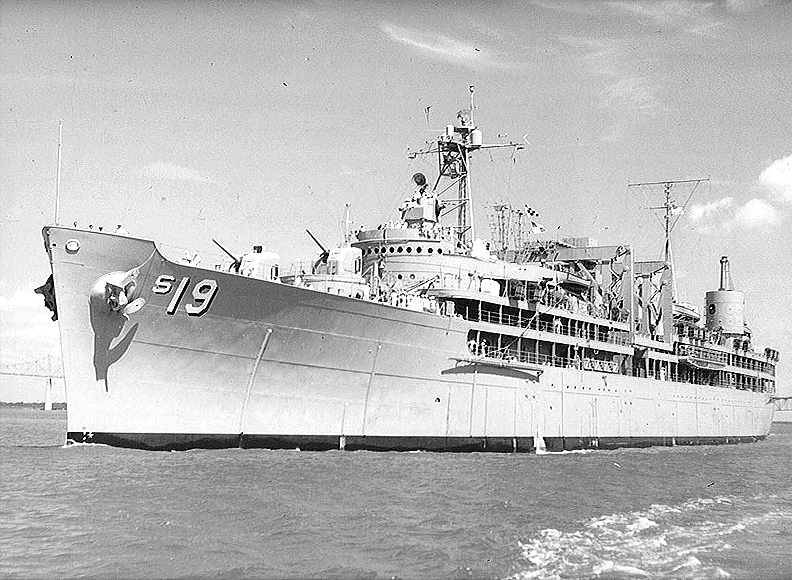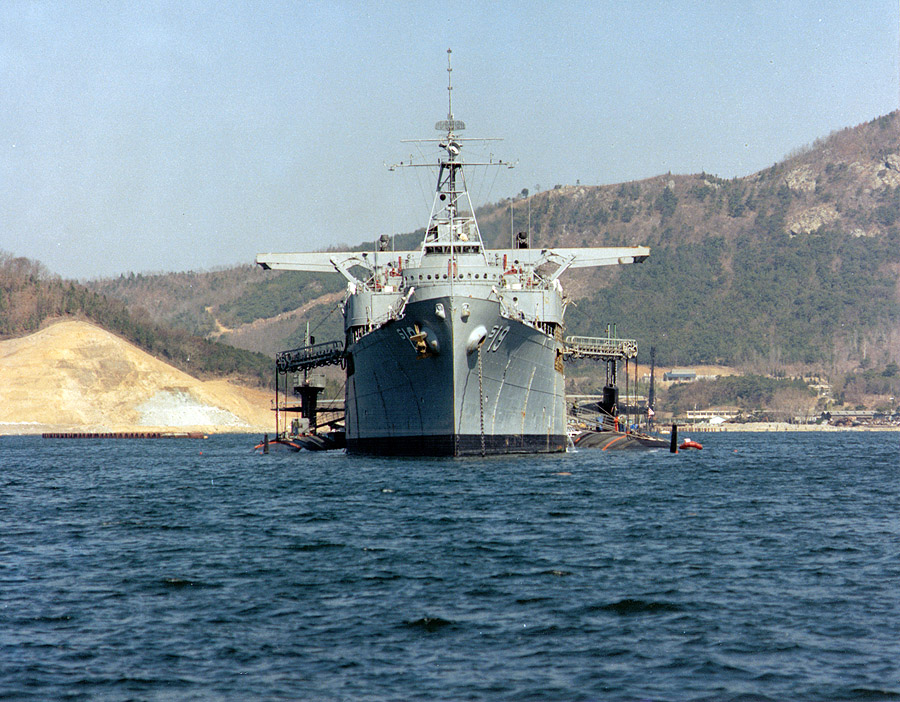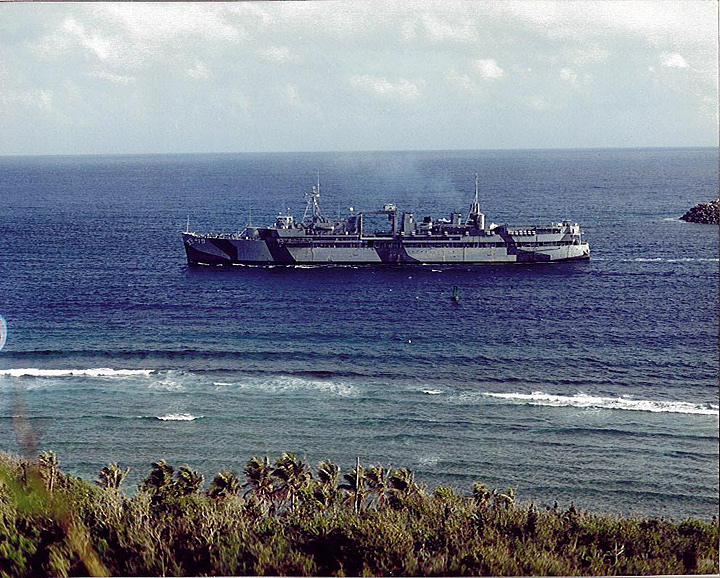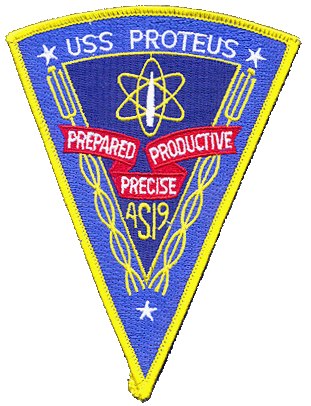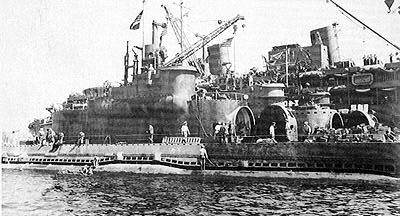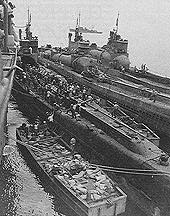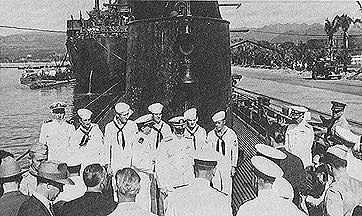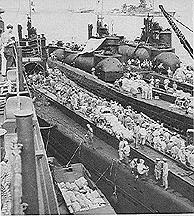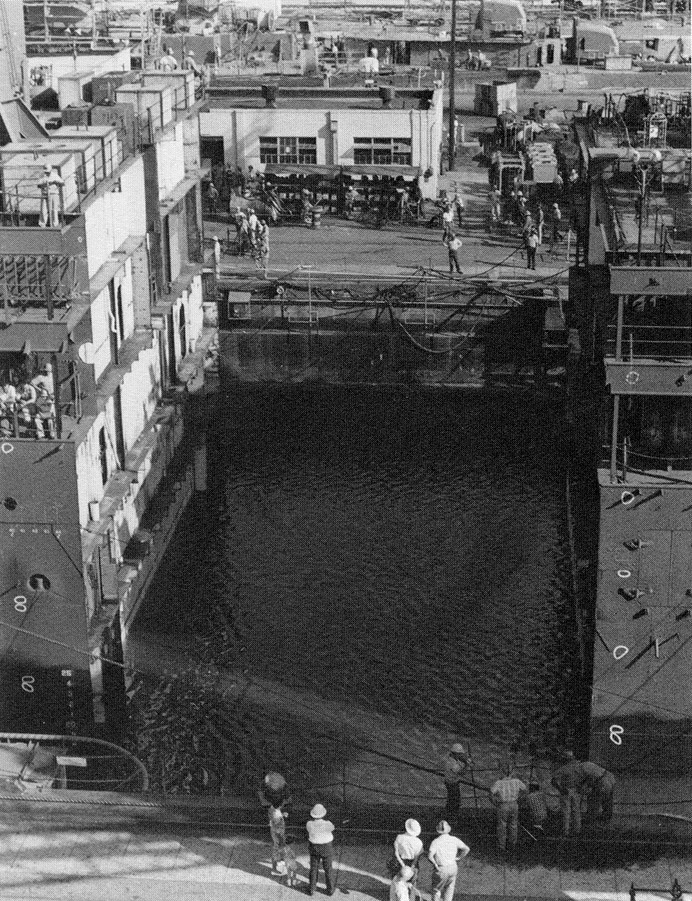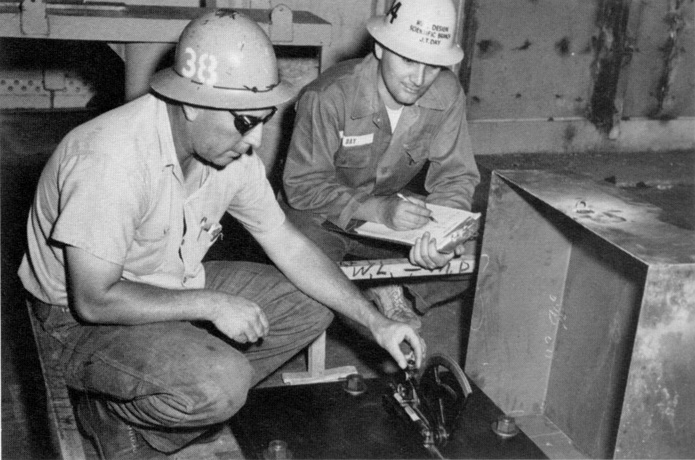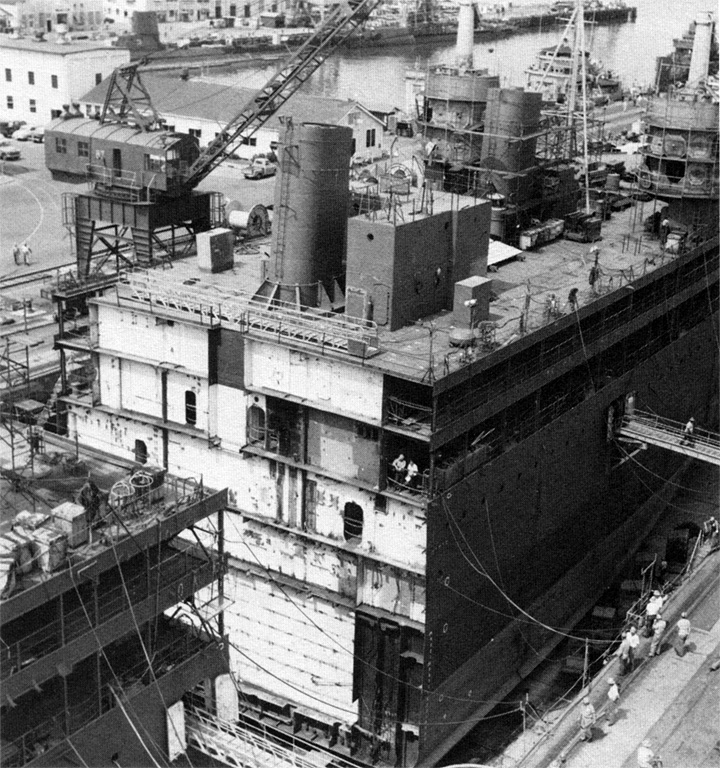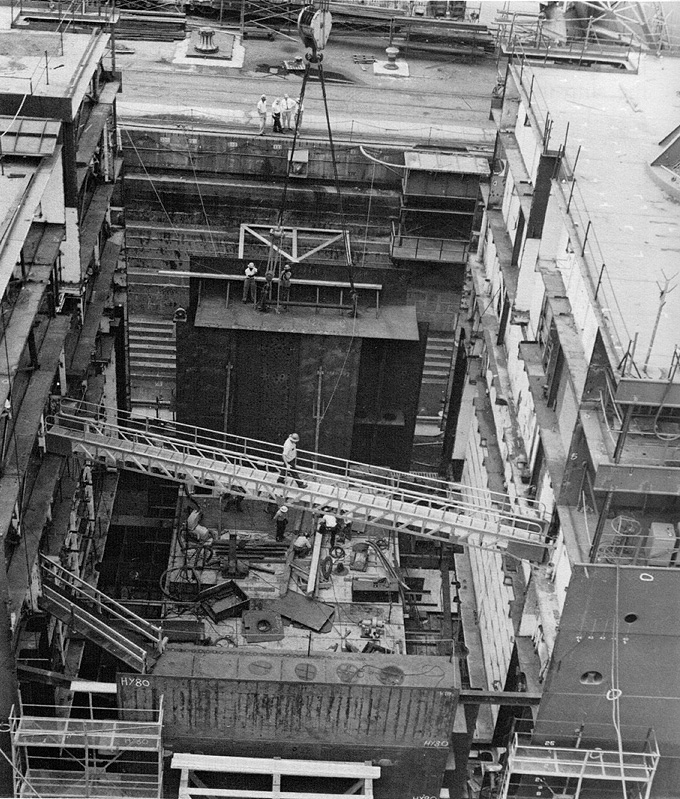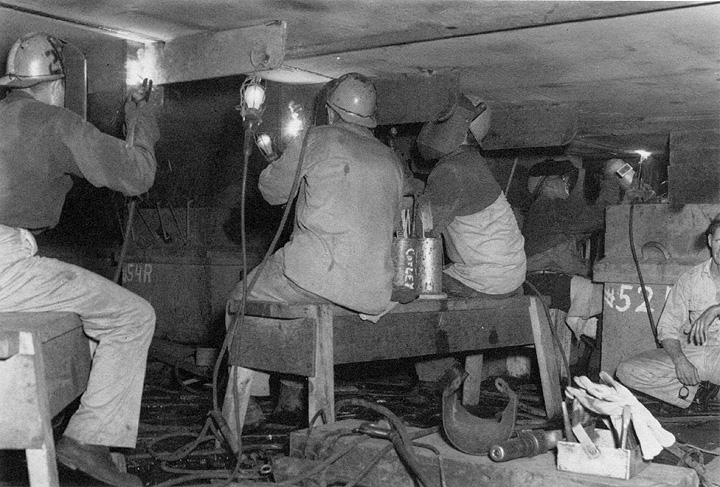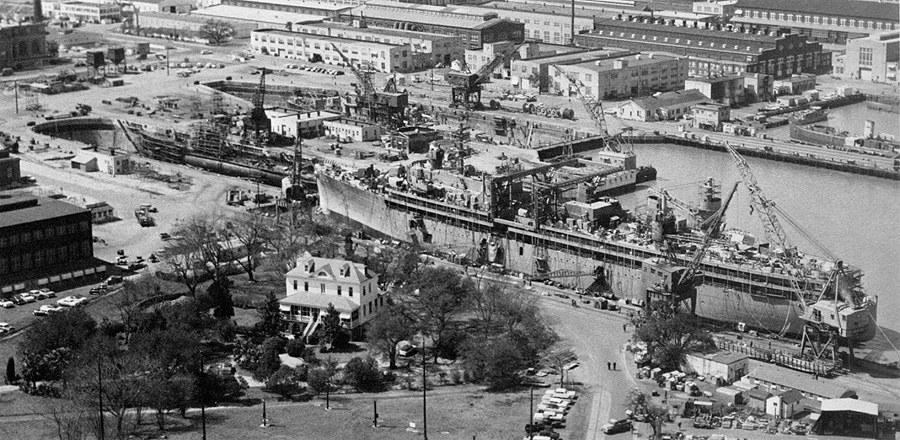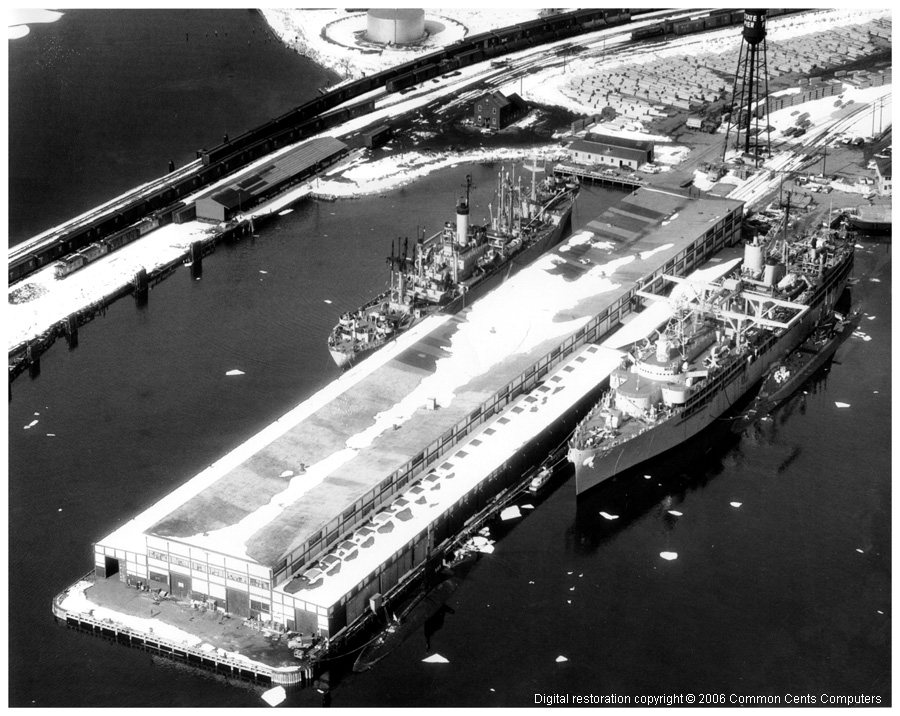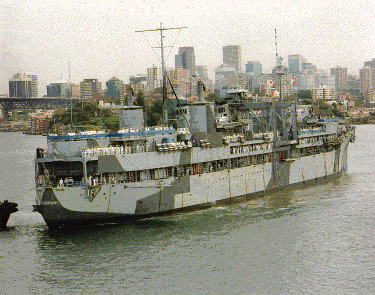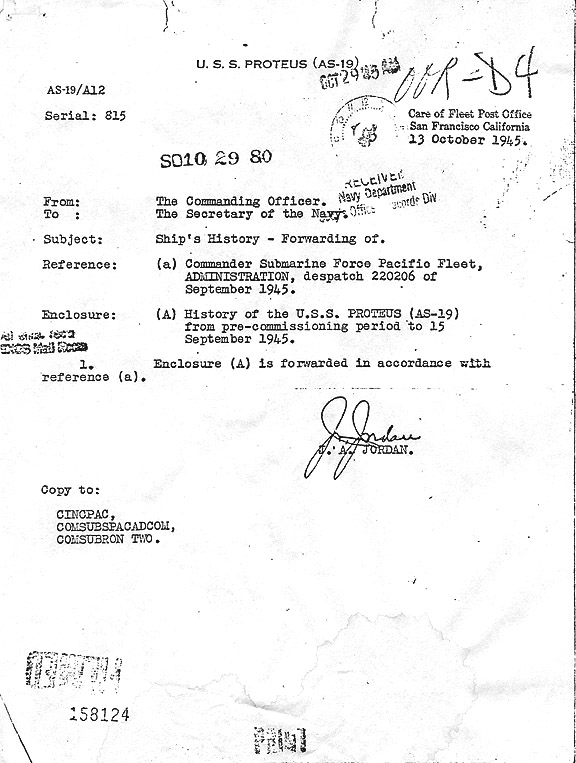 | FACTUAL HISTORY
OF
THE
U.S.S. PROTEUS
(AS19)
FROM
PRE-COMMSSIONING PERIOD
TO
15 SEPTEMBER 1915
[Photo to be added later]
The U.S.S. PROTEUS (AS-19) at Yokosuka Ko, Japan, with her nest of twelve U. S. submarines all of which were present during the signing of surrender terms on 2 September. Photo by Captain Lewis S. Parks, U. S. Navy.
FORWARD
| This history of the submarine tender U.S.S. PROTEUS (AS-19) covers the period from the laying of the keel through 15 September 1945. As directed, it is a factual account and it is not embellished with description. A bibliography will include the official ship's log, war diary, letters and files. The history of the Torpedo Department and the Engineering Department are included as separate entities.
In view of _the ship's service with Submarine Squadron TWENTY during the period from 1 March 1944. through 15 September 1945, an addenda has been made a part of this history and captioned "Factual Review of Submarine Squadron TWENTY". | | FACTUAL HISTORY OF U.S.S. PROTEUS (AS-19) | Actual construction of the submarine tender U.S.S. PROTEUS (AS-19) commenced on 15 September 1941 with the laying of the keel in slip number five at the Moore Drydock Company, Oakland, California. The ship was designed at the United States Navy Yard, Mare Island, Vallejo, California, and constructed in its entirely by the Moore Drydock Company. The actual gross cost amounted to approximately $20,000,000.00, exceeding the original designed cost by approximately $8,000,000.00. Construction continued without delay from 15 September 1941 until the ship was launched. On 12 November 1942, Mrs. Charles Maynard Cooke, 1r. sponsored the U.S.S. PROTEUS (AS-19) as it was officially launched from slip number five at the Moore Drydock Company, Oakland,. California.
Work continued with exceptional speed throughout the year 1943 for the ship was ready for commissioning the first month in 1944. At 1600 on 31 January 1944, Captain Robert A. WHITE, U.S. Navy, placed the U.S.S. PROTEUS (AS-19) in commission, and then turned the vessel over to Captain Robert W. BERRY, U.S. Navy. Commander P. S. TAMBLING, U.S. Navy assumed the duties of Executive Officer.
At the time of commissioning the mission of the U.S.S. PROTEUS was recorded as being "to provide adequate, prompt, and sufficient services to the submarines and related vessels tended." These services are (1) to assist in maintaining their material readiness, (2) to provide an adequate stock of consumable supplies (3) and to enhance the morale of their crews.
On completion and at commissioning the ship was logged as being 15,034 tons with an overall length of 529 feet and 6 inches and a beam of 73 feet and 4 inches.
The commissioning ceremonies were at Hunter's Point in the San Francisco Bay area; and the ship remained there for two weeks loading stores, organizing personnel, and making all material preparations for getting underway in order to conduct initial trials and shakedown the ship and all departments on her first cruise.
Between 11 and 14 February 1944 the U.S.S. PROTEUS was degaussed, depermed, and the ship's compass compensated. On 15 February she got underway for her shakedown cruise as Task Force Unit 14.6.2 in accordance with Commander Task Group 14.6 Operation Order No. 27-44.
On 16 February all guns were fired for the first time, and the engines were test run at flank speed for four hours, and at full speed for four hours. On 17 February the ship arrived at San Diego, California. Trial runs were conducted off Point Loma, California on 18 February, and these included repeated exercises in all ship's drills. Captain Robert W. BERRY, U.S. Navy, commanding, held the first overall inspection of the ship on 19 February. Drills and trials were continued at sea until 25 February on which date the U.S.S. PROTEUS moored again at San Diego. On 29 February in accordance with Commander Task Force 14 Movement Order No. 65-44, preparations were made and the ship got underway at 1745 for the Navy Yard, Mare Island, Vallejo, California, having completed her shakedown cruise. After docking at the Navy Yard, Mare Island, Berth 12, on 2 March, post shakedown repairs commenced, all of which were minor in nature, while an attempt was made to give all hands a brief period of leave in preparation for sailing overseas. Stores and supplies were taken on in huge quantities and final preparations were completed. On 19 March the ship departed the Navy Yard, Mare Island enroute to Pearl Harbor, Oahu, Territory of Hawaii. This departure at 1400 was made in accordance with Commander Pacific Sea Frontier Operation Order and Routing Instructions of I8 March 1944.
On 13 March a dispatch to all appropriate naval commands, including the Commander in Chief, Pacific Fleet reported the U.S.S. PROTEUS (AS-19) as ready for duty with the Fleet and reporting as of 17 March 1944.
On 25 March 1944 at 1047 zone time the ship moored to Berth 20, Submarine Base, Pearl Harbor, Oahu, Territory of Hawaii, the maiden voyage having been completed without incident. This cruise was conducted independently, not with escort or in convoy.
Submarine Squadron TWENTY was assigned to the tender U.S.S. PROTEUS and remained assigned to her from commissioning during the whole of the war. Submarine Squadron TWENTY was commissioned on 1 March 1944 at the Navy Yard, Mare Island, Vallejo, California with Captain Leo L. PACE, U.S. Navy as Squadron Commander, and Commanders Lewis S. PARES, U.S. Navy and Frank W. FENNO, U.S. Navy in command of Submarine Division TWO HUNDRED TWO and TWO HUNDRED ONE respectively. The Squadron, as a unit, took quarters on board the U.S.S. PROTEUS on 2 March 1944. Prior to departure from the Navy Yard, Mare Island, Commander Ralph B. JOHNSON, U.S. Naval Reserve reported on board as Squadron Engineer while Commander Harry C. STEVENSON, U.S. Navy reported on board as Squadron Operations Officer. Relief crews were formed, while living and office quarters for the crew of both Divisions and the Squadron were made; available on the ship. Prior to docking at Pearl Harbor on 25 March 1944 a complete organization was in actual readiness for compliance with the established mission of the tender. The unofficial name of "Tip Top Tender" was assigned to the U.S.S. PROTEUS - a name the organization well earned as the records later have testified.
Submarine Squadron TWENTY was assigned the following twelve submarines which all remained a part of the organization during the war. No Squadron TWENTY submarine was lost to the enemy, nor was any submarine completely refitted by the U.S.S. PROTEUS lost to the enemy.
Submarines assigned were as follows: | | | Initial Commanding Officer | | U.S.S. ASPRO (SS309) | | Commander W. S. STEVENSON, USN. | | U.S.S. BATFISH (SS310) | | Commander W. R. MERRILL, USN. | | U.S.S. ARCHERFISH (SS311) | | Commander G. W. KEHL, USN. | | U.S.S. BURRFISH (SS312) | | Commander W. B. PERKINS, USN. | | U.S.S. SANDLANCE (55381) | | Commander M. E. GARRISON, USN. | | U.S.S. PICUDA (SS382) | | Commander A. RABORN, USN. | | U.S.S. PAMPANITO (SS383) | | Commander P. E. SUMMERS, USN. | | U.S.S. BANG (SS384) | | Commander A. R. GALLAHER, USN. | | U.S.S. PARCHE (SS385) | | Commander L. P. RAMAGE, USN. | | U.S.S. PILOTFISH (SS386) | | Commander R. H. CLOSE, USN. | | U.S.S. PINTADO (SS387) | | Commander B. B. CLAREY, USN. | | U.S.S. PIPEFISH (SS388) | | Commander W. N. DERAGON, USN. | | [Photo to be added later]
The U.S.S. PROTEUS (AS-19) moored to port and the U.S.S. AEGIR (AS-23) moored to starboard at Midway Islands. |
On 28 March 1944 at 1631 the U.S.S. ASPRO (SS309) moored alongside the U.S.S. PROTEUS for the ship's first refit, which was completed on 11 April 1944. The U.S.S. BATFISH (SS310) was the second, submarine to receive a PROTEUS refit which commenced on 15 April and ended 25 April 1944. The U.S.S. PINTADO (SS387) received voyage repairs from the U.S.S. PROTEUS commencing on the 23rd and ending on the 27th of April 1944.
From commissioning until 15 September 1945 the U.S.S. PROTEUS gave complete refits to 48 submarines and 4 surface craft, voyage repairs to 81 submarines and miscellaneous repair assistance to 60 surface ships. In all, the U.S.S. PROTEUS gave service to 189 units of the U.S. Navy during the war - everyone of which was deemed satisfactory.
On 29 April 1944 at 1410 the ship got underway from her mooring at the Submarine Base, Pearl Harbor, T. H., enroute to Midway Islands in accordance with Commander Task Force 17 Operation Order No. 174-44. The U.S.S. PC485 accompanied the U.S.S. PROTEUS as escort. At 0952 on 3 May 1944 the U.S.S. PROTEUS moored starboard side to Berth No. S-3, at Midway Islands, her second cruise having been completed without incident.
The ship remained at Midway Islands until 1 December 1944 and during this period the following work was accomplished: | | SUBMARINE REFITS | | | U.S.S. BANG (SS385) | | 14 May to 28 May | | U.S.S. PARCHE (SS384) | | 24 May to 9 June | | U.S.S. SKATE (53305) | | 1 June to 14 June | | U.S.S. PLUNGER (SS179) | | 30 June to 14 July | | U.S.S. BATFISH (53310) | | 9 July to 24 July | | U.S.S. ARCHERFISH (SS311) | | 15 July to 29 July | | U.S.S. PAMPANITO (SS383) | | 23 July to 6 August | | U.S.S. SUNFISH (SS281) | | 1 August to 12 August | | U.S.S. STERLET (55392) | | 26 August to 9 September | | U.S.S. SAILFISH (55192) | | 6 September to 20 September | | U.S.S. SEAL (SS183) | | 19 September to 1 October | | U.S.S. REDFISH (SS395) | | 2 October to 16 October | | U.S.S. SEARAVEN (SS196) | | 6 October to 20 October | | U.S.S. RAZORBACK (SS394) | | 19 October to 30 October | | U.S.S. WHALE (SS231) | | 29 October to 13 November | | U.S.S. SEADOG (SS401) | | 5 November to 17 November. |
| | SURFACE SHIP REFITS | | | | U.S.S. BERYL | | 26 September to 16 October | | U.S.S. PC1077 | | 1 October to 15 October | | U.S.S. LET | | 15 October to 25 October | | U.S.S. AZURLITE | | 25 October to 15 November | | In addition to the above, voyage repairs were given to 54 U.S. submarines and to 5 U.S. surface ships.
On 9 September 1944, Commander Robert T. RAMSBOTHAM, U.S. Navy, assumed the duties of Executive Officer of the U.S.S. PROTEUS relieving Commander P. S. TAMBLING, U.S. Navy.
Captain Charles N. DAY, U.S. Navy relieved Captain. Robert W. BERRY, U.S. Navy as commanding officer. The time for change of command was logged as being 1100, 13 September 1944 at which time the officers and crew were assembled to witness the reading of orders.
On 15 September 1944, Captain Lewis S. PARKS, U.S, Navy temporarily succeeded Captain Leo L. PACE, U.S. Navy as Commander Submarine Squadron TWENTY and permanently assumed the office on 17 December 1944.
On 2 October, Captain Frank W. FENNO, U.S. Navy received dispatch orders for Temporary Additional Duty which detached him from command of Submarine Division TWO HUNDRED ONE. Captain FENNO left the ship on about 10 October.
On 1 December the ship got underway from Midway Islands enroute to Pearl Harbor, T. H. in accordance with Commander Task Group 17.5 Operation Order No. Se-005, with the U.S.S. LITCHFIELD (DD336) as escort. At 1253 on 4 December the ship moored portside to Berth S-21 at the U.S. Submarine Base, Pearl Harbor, T. H. At 1411 on 18 December the ship got underway to enter Thomas Dry Dock No. 4, and at 1600 was resting on keel blocks. Repairs were made, the bottom scraped and painted by the ship's force, and at 1255 on 23 December the ship was again waterborne and got underway from the drydock, mooring starboard side to the SS PANAMAN between buoys X-2 and X-2S, East Loch, Pearl Harbor, T. H.
[Picture to be added later]
The U.S.S. PROTEUS (AS-19) entering Thomas Drydock Number four at Pearl Harbour Navy Yard, Oahu, Territory of Hawaii.
The ship remained at East Loch until 9 January when, at 1107, she moored port side to berth S-21, Submarine Base, Pearl Harbor, T. H.
Two Extensive voyage repairs and one refit were completed while the ship remained at Pearl Harbor. Work on the U.S.S. CHARR (SS328) started on 9 December and was finished on 30 December, the U.S.S. LARGARTO's extensive voyage repairs started on Christmas Day and ended 23 January 1945, while the refit for the U.S.S. GROUPER (SS214) covered the period between 2 January and 2 February 1945. No work on surface ships was accomplished during this period. All officers and men were pleased to enjoy a brief rest and period of recuperation after spending months on Midway's atoll.
On 7 January 1945, Commander Rob Roy McGREGOR, U.S. Navy reported on board as Commander of Submarine Division TWO HUNDRED TWO.
At 1636 zone time on 5 February 1945 in accordance with Commander Hawaiian Sea Frontier's instruction for Convoy No. 287-T the U.S.S. PROTEUS got underway from berth S-21, Pearl Harbor, Oahu, T. H. enroute to Guam, Marianas Islands. The convoy used a speed of advance of 14.5 knots and Zig Zag plans. The S.S. SEA STURGEON carried the Convoy Commodore, Captain Alvin 0. LUSTIE, U.S. Naval Reserve. Vice Convoy Commodore remained with Captain Charles N. DAY, US. Navy in the U.S.S. PROTEUS, while the remaining ship in the convoy was the S.S. WELTEVREDEN. The U.S.S. THADEUS PARKER (DE369) and the U.S.S. DOHERTY (DE14) acted as escorts.
At 0900 zone time on 9 February the International Date Line was crossed. At 0820 zone time at latitude 11°29’ North, longitude 162°23’ East, due south of Eniwetok the S.S. SEA STURGEON, S.S. WELTEVREDEN, and the U.S.S. THADEUS PARKER left the convoy while the U.S.S. PR0TEUS US escorted by the Destroyer Escort, U.S.S. DOHERTY (DE14) proceeded as directed by instructions of Commander Hawaiian Sea Frontier order to Convoy 287-T. At 0934 zone time on 16 February 1945 the U.S.S. PROTEUS moored in Berth 20, Apra Harbor, Guam, Marianas Islands. During the cruise enroute to Guam a total of 3934 rounds of 20MM ammunition, 855 rounds of 40MM ammunition, and 54 rounds of 5"/38 ammunition was expended for training purposes. While enroute on 14 February the U.S.S. DOHERTY (DE14) was refueled with 33,410 gallons of diesel oil. No contact with the enemy eras made during the cruise.
On 16 February 1945, Submarine Division EIGHTY TWO took quarters on board the U.S.S. PROTEUS and commenced assisting in the refit and repair of all ships. Commanded by Commander Lowell T. STONE, U.S. Navy, the Division remained on board until 21 April 1945.
On 13 April 1945 Commander Nicholas T. NICHOLAS, U.S. Navy reported on board as Executive Officer of the U.S.S. PROTEUS relieving Commander Robert J. RAMSBOTHAM, U.S. Navy on 14 April who left the ship to take command of the U.S.S. SPERRY (AS12).
On 23 April 1945, Submarine Division ONE SIXTY ONE took quarters on board the U.S.S. PROTEUS and commenced assisting in the refit and repair of all ships. Commanded by Commander Earl R+ HAWK, U.S. Navy, the Division remained on board until 2 September 1945.
The day the U.S.S. PROTEUS arrived in Guam, M.I. was the day an extensive and long period of refits was started, the first being the U.S.S. SPADEFISH (SS411) whose refit ended 26 February. Others in chronological order follow: | | U.S.S. DEVILFISH (SS292) | | 16 February to 26 February | | U.S.S. BLACKFISH (SS221) | | 21 February to 9 March | | U.S.S. BANG (SS385) | | 24 February to 10 March | | U.S.S. SUNFISH (SS281) | | 27 February to 13 March | | U.S.S. GATO (SS212) | | 13 March to 27 March | | U.S.S. HADDOCK (SS231) | | 19 March to 3 April | | U.S.S. SPRINGER (SS414) | | 24 March to 8 April | | U.S.S. TREPANG (SS412) | | 25 March to 8 April | | U.S.S. TINOSA (SS283) | | 7 April to 17 April | | U.S.S. BALO (SS285) | | 8 April to 22 April | | U.S.S. ICEFISH (SS367) | | 20 April to 4 May | | U.S.S. SPADEFISH (SS411) | | 21 April to 5 May | | U.S.S. CREVALLE (SS2 91) | | 3 May to 14 May | | U.S.S. TRUTTA (SS421) | | 4 May to 18 May | | U.S.S. SPOT (SS413) | | 4 May to 17 May | | U.S.S. TINOSA (SS283) | | 16 May to 22 May | | U.S.S. SPRINGER (SS414) | | 18 May to 1 June | | U.S.S. RATON (SS270) | | 25 May to 9 June | | U.S.S. COD(SS224) | | 29 May to 12 June | | U.S.S. PETO (SS265) | | 19 June to 3 July | | U.S.S. JACK (SS259) | | 16 June to 2 July | | U.S.S. DRAGONET (SS293) | | 10 June to 24 June | | U.S.S. TIGRONE (SS419) | | 3 July to 17 July | | U.S.S. CAVALLA (SS244) | | 8 July to 2 August | | U.S.S. HACKLEBACK (SS295) | | 12 July to 3 August | | U.S.S. PINTADO (SS387) | | 14 July to 6 August | | U.S.S. PADDLE (SS263) | | 18 July to 1 August | | U.S.S. QUILLBACK (SS424) | | 24 July to 7 August | | Meeting all submarines upon their return from war patrol the tender gave the fighting ships every attention. Fresh fruit, ice cream, and mail were taken on board immediately. Medical and dental attention was arranged for all officers and men. All soiled laundry was collected and promptly done. The officers and crew were given immediate transportation to a rest and recuperation camp where they remained for approximately two weeks while the U.S.S. PROTEUS and the relief crews thoroughly cleaned their ship, in addition to refueling and stacking the submarines with provisions and getting them, in every way, again ready for sea.
[picture to be added later]
The U.S.S. PROTEUS. AS-19 at Midway Islands with the submarines U.S.S. BRIG, U.S.S. PINTADO, and U.S.S. PILOTFISH.
The shortest refit service given to a submarine was given to the U.S.S. TINOSA (SS283). It commenced on 16 May and was completed on 22 May. The repair department worked through this assignment on a 24 hour basis.
The longest refit service was that given to the U.S.S. GROUPER (SS214) which commenced on 2 January and ended on 2 February. This exceptionally long period of time was taken due to the necessity of removing and reinstalling all cells of both main storage. batteries.
At commissioning and until 9 September 1944 the Repair Officer of the U.S.S. PROTEUS was Commander Robert J. RAMSBOTHAM, U.S. Navy who was succeeded on 9 September by Lieutenant Commander Warren L. BAILEY, U.S. Naval Reserve. The number of men attached to the Repair Department varied from 355 at time of commissioning to a maximum of 504 during the time the ship was. station at Guam, M.I. Additional voyage repairs while at Guam were given to seven submarines, while repair work to surface ships and outside activities as separate units numbered forty.
On 17 March 1945 on board the U.S.S. PROTEUS, Commander Eugene T. SANDS, U.S. Navy assumed the duties of Commander Submarine Division TWO HUNDRED ONE relieving Captain Frank W. FENNO, US. Navy.
On 2 July 1945 on board the U.S.S. PROTEUS, Commander Bernard F. McMAHON, U.S. Navy relieved Commander Eugene T. SANDS, U.S. Navy as Commander of Submarine Division TWO HUNDRED ONE.
At noon of 15 August 1945, the Commander Submarine Force, Pacific Fleet, Vice Admiral Charles A. LOCKWOOD, Jr., U.S, Navy, issued orders to the U.S.S. PROTEUS and Commander Submarine Squadron TWENTY to proceed enroute to Japan to participate in the invasion, surrender and occupation of the Japanese home islands. At 0716 16 August 1945 the U.S.S. PROTEUS was underway from Guam, M.I. in accordance with ComSubsPac Order No. 205-45, in company with the U.S.S. GREENLET (ASR10) and the U.S.S. DALE (DE353). The three ships formed Task Group 17.11 with Commander Submarine Squadron TWENTY as Group Commander.
Prior to getting underway additional experienced submarine personnel were immediately ordered to the U.S.S. PROTEUS and Submarine Squadron TWENTY from units in Guam, in order to make available the maximum number of prize crews to man enemy submarines captured on the high seas or seized in Japan proper. All submarine officers and men on Guam volunteered. Unloading all unnecessary gear and loading supplies, provision, ammunition, and other necessities was a mammoth undertaking to be accomplished within a few hours - however it was accomplished with energetic efficiency allowing the ship to depart Guam on schedule. Approximately 400 tons of gear was loaded on board within a period of six hours.
Rendezvous was made 270 miles south and east of Tokyo on 19 August with the U.S. Third Fleet. On 20 August the Commander Third Fleet ordered Commander Submarine Squadron TWENTY in the U.S.S. PROTEUS as Commander. Task Group 35.80 and formed the group as a support force consisting of twenty-six ships. An uneventful six days of steaming within the area north of latitude 31° North and west on longitude 145° East was terminated at 2320 on 26 August upon receipt of orders from the Commander Third Fleet ordering Task Group 35.80 to proceed to an assigned anchorage in Sagami Wan, off Honshu, Japan, preparatory to entering Tokyo Bay.
A dispatch to Commander Third Fleet was intercepted at 1200 on 27 August. It contained information of an aircraft contact with a Japanese submarine flying the designated surrender colors at latitude 38°40' North, longitude 143°121’ East. In anticipation all preparations were made to have one of the twelve previously formed prize crews ready for immediate departure. Each crew consisted of four officers and forty men. Commander Hiram H. CASSIDY, U.S. Navy, formerly of the U.S.S. TIGRONE (SS419) was designated as prospective commanding officer of the first surrendered Japans submarine. Officers attached to his command were Lieutenant James H. KING, U.S. _Navy, Lieutenant (junior grade) Clay V. JOHNSON, U.S. Navy, and Machinist Bernise F. JOHNSON, U.S. Navy. Commander Third Fleet ordered the ,prize crew to proceed from the U.S.S. PROTEUS to the Japanese submarine and take command. Meanwhile plane contact was made on a second Japanese submarine at latitude 37°42’ North and longitude 144°52’ East with surrender colors flying. A second prize crew was ordered by Commander Third Fleet, Commander Clyde B. STEVENS, U.S. Navy formerly Commanding Officer of the U.S.S. PLAICE (SS309) was assigned the task. Officers comprising the group were Lieutenant Joseph E. GOULD, U.S. Navy, Lieutenant (junior grade) James A. APPLETON, U.S. Naval Reserve, and Electrician "J" "D" ELLIS, U.S. Navy. Within the hour both prize crews were enroute to the. Japanese submarines. The U.S.S. WEAVER (DE741) transported Commander Hiram H. CASSIDY's crew; the U.S.S. BANGUST (DE739) transported Commander Clyde B. STEVEN's crew. Task Group 35.80 continued on towards Sagami Wan, Japan.
Mount Fujisan, on the Japanes mainland, bearing 320° True, distance 109 miles, was sighted at 0710, zone time, on 28 August 1945. At 0735 Japanese Lieutenant T. IWANA HIJAM, pilot, and Japanese Lieutenant K. MOTOKI, interpreter, were received on board by boatswain's chair. At 1705 the U.S.S. PROTEUS anchored in Berth 31, Sagami Wan, Honshu, Japan.
On 29 August at 0915 the surrendered Japanese submarine I-400 with U.S, prize crew commanded by Commander Hiram CASSIDY, U.S. Navy moored alongside to port At 0955 the surrendered Japanese submarine I-14 with U.S. prize crew commanded by Commander Clyde B. STEVENS, U.S. Navy, moored alongside to port and outboard of the I-400.
On 0820 on 30 August the U.S.S. PROTEUS and the two surrendered Japanese submarines got underway enroute to Tokyo Bay and anchored there in Berth 84 at 1458. This movement was in accordance with verbal orders of Commander Task Group 35.80. Seven different mine fields were passed close aboard in this movement.
Immediately upon anchoring three demilitarization units from Submarine Division ONE SIXTY ONE, TWO HUNDRED ONE, and TW0 HUNDRED TWO, went ashore to occupy the Yokosuka Submarine Base, Yokosuka, Japan.
During the entire cruise from Guam to Japan a total of 3,650 round of 20MM, 677 round of 40MM, and 21 rounds of 5"/38 ammunition was expended for training purposes, One floating mine was destroyed by the escort U.S.S. DALE (DE353).
On 31 August at 1445 the ship again got underway to shift berths and proceeded to within the breakwater of Yokosuka Naval Base in Yokosuka lagoon adjacent to the Japanese Submarine Base. The U.S.S.. PROTEUS was anchored bow and stern at 1650.
Both the I-400, largest submarine in the world, and the I-14 accompanied the ship to her new anchorage. A third Japanese submarine, the I-401, joined the group at this time as an additional Japanese prize-of-war. The 1-401 was intercepted on the high seas by the U.S.S. SEGUNDO (SS398) and turned over to the forces of Submarine Squadron TWENTY on board the U.S.S. PR0TEUS on 31 August 1945. With orders from Captain Lewis S. PARKS, U.S. Navy, overall commander of-submarine activity in the Tokyo area, Commander A. C. SMITH, U.S. Navy had proceeded to sea on 31 August and taken charge of the I-401 relieving the commanding officer of the U.S.S. SEGUNDO (SS398), Lieutenant Commander S. L. JOHNSON, U.S. Navy and brought the captured Nipponese submarine into port. The I-401 was the only one of the three Japanese subs that was intercepted on the high seas and forced into port while the other two surrendered.
Commander Yokosuka Occupation Force assigned to Submarine Squadron TWENTY on board the U.S.S. PROTEUS the mission of expeditiously demilitarizing all submarines, human torpedoes, torpedo carrying boats, and suicide boats at Yokosuka, Shimada, and other places in the Sagami Wan - Tokyo Bay areas.
The U.S.S. PROTEUS was assigned the task of tending fleet units and serving as issue ship for food-stuffs, clothing, ships stores, and special items for repatriate prisoners of war.
Immediately upon anchoring on 30 August, Vice Admiral Charles A. LOCKWOOD, Jr., U.S. Navy took quarters on board the U.S.S. PROTEUS, his presence in the area being to represent the U.S. Naval submarine forces at the formal signing of the surrender documents on 2 September on board the U.S.S. MISSOURI (BB63). As per orders of the Commander Submarine Force, Pacific Fleet, twelve U.S. submarines also had been ordered to be present in Tokyo Bay with the tender U.S.S. PROTEUS. These twelve submarines nested alongside the U.S.S. PROTEUS on 31 August in Yokosuka lagoon. | | To port: | | To starboard: | | U.S.S. RUNNER (SS476) | | U.S.S. ARCHERFISH (SS311) | | U.S.S. GATO (SS212) | | U.S.S. MUSKALLUNGE (SS262) | | U.S.S. SEACAT (SS399) | | U.S.S. CAVALLA (SS244) | | U.S.S. PILOTFISH (SS386) | | U.S.S. RAZORBACK (SS394) | | U.S.S. TIGRONE (SS419) | | U.S.S. HADDO (SS255) | | U.S.S. HAIL (SS256) | | U.S.S. SEGUNDO (SS398) |
| On 2 September at 0945 the flag of Vice Admiral Charles A. LOCKWOOD, Jr.,, was raised on the Japanese submarine I-100 during the signing of the surrender ceremonies and remained flying there for several hours. At 0600 on 3 September, Vice-Admiral LOCKWOOD left the ship and the area. Commencing at 0900 on 3 September all twelve U.S. submarines moored alongside got underway leaving the three Japanese submarines I-400, I-401, and I-14 and the U.S.S. PROTEUS moored within Yokosuka lagoon. The three subs then nested abreast of the tender.
Work consisting of maintenance and voyage repairs was given to all twelve American submarines while moored alongside.
On the 4th of September 1945 within Yokosuka breakwater, off Yokosuka Submarine Base, Japan, at 0955 Captain James A. JORDAN, U.S. Navy relieved Captain Charles N. DAY, U.S. Navy as commanding officer of U.S.S. PROTEUS. The officers and crew were assembled on the boat deck at 0955 to witness the reading of orders.
Prior to 15 September 1945 and while in Japan, voyage repairs and individual work was accomplished on 15 different ships and separate units of the fleet by the Repair Department. This was in addition to giving complete attention to approximately 100 job orders for each Japanese submarine.
Duties of the U.S.S. PROTEUS and Submarine Squadron TWENTY in connection with demilitarizing the Japanese Submarine Base and converting the three Japanese submarines into an American standard of cleanliness and repair continued through 15 September.
During the period from mooring in Yokosuka lagoon to 15 September, and in the process of demilitarization, the following diving activities were accomplished by the U.S.S. PROTEUS’ officers and men: (1) Inspections were made on 33 Japanese midget submarines for warheads and explosives, (2) Underwater inspections were made on the mooring buoys for the U.S.S. SAN DIEGO (CL53), U.S.S. PROTEUS, and numerous smaller ships within the harbor, (3) Underwater inspection was made of the 1-372, sunken Japanese cargo submarine, (4) Eleven midget and two-man Japanese submarines were salvaged for intelligence purposes in water ranging from 30 to 150 feet in depth.
Dives, in general, were made in shallow water with a face mask; a total of 251 separate dives were made to accomplish the desired work.
The officer responsible for supervising all such work and dives was Lieutenant James SWANBECK, U.S. Navy. While the diving responsibility and actual work was done by W. D. HERR, CSF, US. Navy.
| | TORPEDO HISTORY | A factual report of the Torpedo Department of the U.S.S. PROTEUS (AS-19) follows as a separate entity for convenience and clarity since it serves its purpose as a more understandable and concise history by means of this arrangement.
At the time of commissioning the U.S.S. PROTEUS the Torpedo Department consisted of 53 men, 5 CTMs and the following officers: -
Lieutenant (j. g.) W. J. WAYMAN, U.S. Navy - Torpedo Officer
Ensign W. V. A. CLARK, Jr., U.S. Naval Reserve - Shop Superintendent, Electric Torpedoes.
Torpedoman A. 0. TORKILDSON, U.S. Navy - Shop Superintendent, Steam Torpedoes
Torpedoman J. C. WIEGMAN, US. Navy - Shop Superintendent, Torpedo Tubes
Actual overhaul of steam torpedoes was commenced on 27 March 1941, and was maintained on a continuous basis until 14 August 1945 except for periods when the vessel was underway. Overhaul of electric torpedoes was commenced on a small scale in April 1944. During the period from March 1944 until August 1945 a total of 1,296 different torpedoes was handled by the U.S.S. PROTEUS. 1,161. torpedoes received complete overhauls, and 910 warshot torpedoes were loaded aboard submarines for war patrols. Torpedoes were loaded on or off 83 different submarines. 218 exercise torpedoes were fired.
During the initial "refit training" period during March and April 1944, the : U.S.S. PROTEUS, overhauled 71 steam torpedoes. One submarine was given a complete load of steam warshots, and 9 steam exercise torpedoes were fired. Five electric exercise torpedoes were fired with poor results, two being lost.
During the 7 months the U.S.S. PROTEUS was at Midway, 466 torpedoes were completely overhauled. A program of extensive exercise firings was carried out, 94 steam torpedoes and 40 Mark 18 torpedoes were fired both for submarine training and torpedo testing purposes. The overhaul of Mark 18 torpedoes was placed on an equal basis with steam torpedoes in August, when the first full load of electric torpedoes was loaded aboard the U.S.S. PAMPANIT0 (SS383).
The torpedo Tube Repair Shop under th direction of Torpedoman J. C. WEIGMAN, U.S. Navy performed complete tube refits on all submarines tended by the U.S.S. PROTEUS. A program of shutter alteration was carried out at this time with considerable success.
On 1 September 1944 Lieutenant W. J. WAYMAN, U.S. Navy was relieved as Torpedo Officer by Lieutenant (jg) W. V. A. CLARK, Jr., U.S. Naval Reserve. At this time the department consisted of approximately 80 men.
During the six months the U.S.S. PROTEUS was at Guam, MI., 537 torpedoes received overhauls. Torpedoes were loaded on or removed from 45 different submarines. 43 steam and 13 electric exercise shots were fired.
At Guam, the U.S.S. PROTEUS received on board a special weapons project which operated as part of the Torpedo Department. Consisting originally of one officer and five men, this project expanded continually until, at the war’s end, five officers and twenty-one men were employed. This unit provided special weapons and carried out a training program for all submarines and tenders in the Guam area. Over 300 special weapons .units were loaded aboard submarines.
Operations were carried out at Guam with difficulty. At its peak, the Torpedo Department consisted of 121 men working in three shifts to obtain maximum output. Torpedo overhaul and handling were constantly hampered by the loss of operating space involved in maintaining the special weapons project, also with the large number of submarines nested alongside, and crowded conditions aboard the tender itself. At times, over 50% of the torpedo personnel were under medical treatment for heat rashes while the ship was in the tropics.
Exercise losses during the period from March 1944. until August 1945 were 4.8%, including several torpedoes lost during early training operations as a result of severe weather conditions. Less than 2% of exercise firings were erratic.
Complete information available on 15 September 1945 indicates that of the 910 war shot torpedoes loaded aboard submarines for war patrols, 350 were fired for 132 hits. This resulted in the sinking of 56 enemy ships, and the damaging of 9 others.
After arrival of the U.S.S. PROTEUS in Yokosuka, Japan on 31 August 1945, the torpedo department personnel engaged in the analysis of Japanese torpedoes and other items of Japanese underwater Ordnance.
{This concludes the Captain's report}
|
|
Other tenders would follow in her path and perform well - but Proteus would blaze the trail. Completing that first refit, she then crossed the Atlantic to Holy Loch, Scotland arriving 3 March 1961. Her first customer at Holy Loch was the Patrick Henry (SSBN 599) and the first over-seas missile exchange was completed (picture below on this page of missile ops between Proteus and Henry).
Over the next two years she completed 38 refits of Fleet Ballistic Missile submarines, for which she received the Navy Unit Commendation. Back at Charleston for overhaul in 1963, on 2 January 1964 she resumed operations at Holy Loch to provide support and refits to the Fleet Ballistic Missile submarines of Submarine Squadron 14.
On 24 February Proteus arrived at Rota, Spain, to establish the second overseas replenishment site for Fleet Ballistic Missile submarines, returning to Holy Loch 12 April. On 29 June she put in at Charleston and on 16 October was enroute to Guam.
Arriving Apra Harbor 29 November 1964, she established the third overseas replenishment site for the Fleet Ballistic Missile submarines - her first SSBN customer in the Pacific was the Daniel Boone. Nearly 19 years later - Proteus was once again in the submarine support business in Apra Harbor, Guam.
History from the Dictionary of American Fighting Ships. Supplemented
She continued to operate at Apra Harbor and in the Pacific for the next seven years, taking a five-month time off for self-overhaul in 1968 - relieved by Hunley (AS-31).
In 1971, after a brief R&R visit to Pearl Harbor, Proteus proceeded to Mare Island for an extensive overhaul, including a significant propulsion upgrade. Shake-down was accomplished out of Pearl Harbor, and after an R&R port call to Sydney Australia, Proteus returned to Apra Harbor for the now routine exchange with Hunley (AS-31).
The exchange was completed by mid January, 1973, and Proteus resumed her duties - expecting no significant interruptions until her scheduled departure (and retirement) date in 1978. When Saigon fell in 1975, thousands of Vietnamese fled their country, and many made the crossing to Guam - some 100,000 of them. In a massive undertaking called "Operation New Life" - every able-bodied individual who could be spared was "volunteered" to help provide facilities to care for this "tidal wave" of humanity. As part of that effort - over 1,000 officers and men from Proteus worked with Seabee construction personnel to erect the refugee city "Tent City" on Orote Point, Guam - leaving only a hand-picked skeleton crew of individuals aboard to see to her safety and security; as well as handle emergencies from the boats that were in. But for that week, Proteus was out of business as usual - for which the Secretary of the Navy awarded Proteus her second Meritorious Unit Commendation in 1975; and she (along with other participating Navy Units) were awarded the first award of the Navy Humanitarian Service Medal (established by Executive Order January 1977 for actions beginning 1 April 1975).
In 1976 Proteus received her third consecutive Engineering "E" and second Humanitarian Medal for Typhoon Pamela Disaster Relief; and the Battle Efficiency "E" in 1978. That year, Proteus was sent to overhaul at Long Beach Naval Shipyard rather than the expected retirement and decommissioning.
Upon returning to Guam in May 1980, after a visit to Mazatlan, Mexico, Proteus resumed refit duties for the remaining SSBNs in the western Pacific. Polaris system support continued until the last SSBN - the Robert E. Lee, departed Guam in July 1981. Proteus then embarked on a major conversion to general fleet support, culminating in a deployment with the Seventh Fleet to the Indian Ocean. The ship supported submarines and surface ships at Diego Garcia, then visited Fremantle, Western Australia, and Subic Bay before returning to Guam in April 1982. The Secretary of the Navy awarded Proteus her third Meritorious Unit Commendation for service in support of the Seventh Fleet. In October 1982, Proteus again departed Guam to provide support to Seventh Fleet ships operating in the Pacific. Following a three month fleet support period at Subic Bay, the ship made a port call at Hong Kong before returning to Guam. During the deployment, Proteus was the recipient of her second consecutive Golden Anchor award and Battle Efficiency "E".
During 1983, Proteus departed Guam in April for a three month deployment to Subic Bay for fleet support and upkeep of units operating in the Pacific and Indian Oceans, returning to Guam in late June. Proteus again deployed to Subic Bay in September to conduct fleet support and upkeep, returning to Guam in December.
On 31 January 1984, Proteus celebrated her 40th birthday, which was marked by a solemn ceremony presided over by the Archbishop of Guam. On 14 May, Proteus departed Guam on an extended deployment to the Indian Ocean. The ship visited Singapore en route to Diego Garcia, and Fremantle and Darwin, Australia, during the return voyage to Guam, arriving at Apra Harbor on 12 October. During 1984, Proteus received her fourth consecutive Battle Efficiency "E" and Golden Anchor award.
From January to July 1985, Proteus underwent the first phase of incremental overhaul, including three months in floating dry-dock, at the Naval Ship Repair Facility, Guam. During overhaul, the ship continued to render logistic and repair support to submarines stopping at Guam, as well as Tiger Team support to submarines in other locations. Proteus departed Guam on 3 July, 1985 for Subic Bay and Hong Kong, returning on 31 August. Following this deployment, Proteus was awarded a second consecutive Engineering "E" and an unprecedented fifth consecutive Golden Anchor award -- the latter was presented personally by the Commander in Chief, U. S. Pacific Fleet, in January 1986.
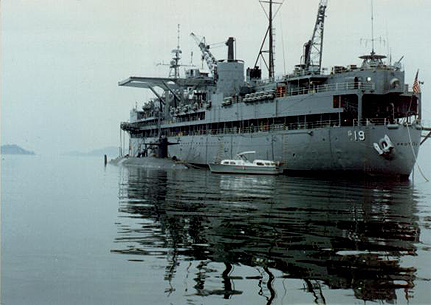 | Proteus tending subs in Chinhae, Republic of South Korea
Picture courtesy Nathaniel J. Farmer | Proteus deployed again on 12 February 1986, spending four weeks in Subic Bay, paying a short port call at Hong Kong, and then proceeding to Chinhae, South Korea, for a three week stay that featured logistic and repair service to six submarines. Following return to Guam on 3 April, Proteus hosted the first western Pacific Trident SSBN refit and crew exchange when the USS Georgia (SSBN 729) moored alongside in outer Apra Harbor from 30 April to 10 May, 1986. Throughout the summer and early fall of 1986, Proteus provided repair and logistic support to submarines visiting Guam. Additionally, from July to October, the ship underwent the second phase of incremental overhaul.
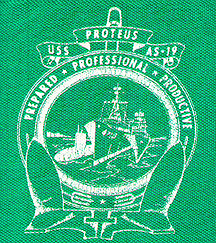 | During these "post boomer" years - Proteus used this alternate crest and motto.
Crest Courtesy James Sumner
| In 1987 and 1988, Proteus deployed to Chinhae, Subic Bay, Hong Kong, and Sasebo and Yokosuka, Japan, in support of submarines operating in the western Pacific. The ship won the Battle Efficiency "E" in 1988, and completed the third phase of incremental overhaul at the Naval Ship Repair Facility, Guam.
In January 1989, Proteus celebrated 45 years of service to the U. S. Navy with an all hands picnic at Polaris Point Beach, Apra Harbor, Guam. In March, Proteus got underway for a spring deployment. The first stop was Hong Kong, and then it was on to Chinhae, where Proteus continued her mission with upkeep provided to submarines and surface units of the Seventh Fleet. The cruise continued with port calls at Sasebo, Pattaya Beach, Thailand, and Subic Bay. In September and October, 1989, the ship visited the Marshall Islands, New Guinea, and Cebu in the Philippines.
From March to June of 1990 and 1991, Proteus made western Pacific cruises and visited Hong Kong, the Philippines, and Japan. Home only three weeks from her most recent deployment, Proteus was called away to help in the relief effort following the eruption of Mount Pinatubo in the Philippines. Operation Fiery Vigil saw the crew digging out facilities both on Subic Bay Naval Base and the nearby town of Olongapo. The ship returned to Guam on 15 August, 1991.
Proteus made her final voyage in April and May of 1992, sailing to Australia where the ship made port calls at Sydney and Brisbane and participated in the Coral Sea festival (Third picture from top and below).
The ship was inactivated at Apra Harbor, Guam, on 11 July, 1992. Proteus proceeded to Bremerton, where she was decommissioned and stricken in September 1992.
In 1994, Proteus was re-instated as IX 518 - Berthing Auxiliary - and provided berthing, messing and workspace for ships' crews undergoing overhaul at Bremerton. The first ship to benefit from IX-518's facilities was the USS Nimitz (CVN-68) (29 January 1994 to 20 August 1994), followed by USS Carl Vinson (CVN-70). Carl Vinson's historical record from her overhaul period (12 January 1997 to 12 September 1997) noted: "The Avionics and Armament Divisions (IM-3) relocated the Calibration Laboratory to submarine tender Proteus (AS-19), which had been decommissioned on 30 September 1992 and occupied a nearby berth. Taking advantage of the tender included completely calibrating two jet engine test facilities". Proteus served in this capacity for another five years - until September 1999 when she was once again placed out of service, and stored at Suisun with the MARAD ghost fleet.
December, 2007 proteus was broken out of the reserve fleet as Suisun, and towed to Esco Marine, Brownsville, TX - where she was scrapped, work being completed in February, 2008.
When Proteus was recommissioned in 1960 - the crew adopted the motto: "Prepared, Productive, Precise. Another word can easily be added to sum up the history of the Old Pro: Proud
History from 1973 - 1992 updated and completed by:
H. A. Oliver III, CAPT USN (Ret'd) CO PROTEUS - 7/84 to 10/86.
The information was taken from his Change of Command program, (10 November, 1986); and the Inactivation Ceremony program (11 July, 1992) - and we are grateful to him for providing this history.
Information from 1992 - 1994 here provided by Randy Guttery, taken from the official records of USS NIMITZ and USS CARL VINSON, and supplemented by Ben Cantrell, aboard IX-518 1992-1999. More info from Ben Cantrell is on IX-518s page - link below.
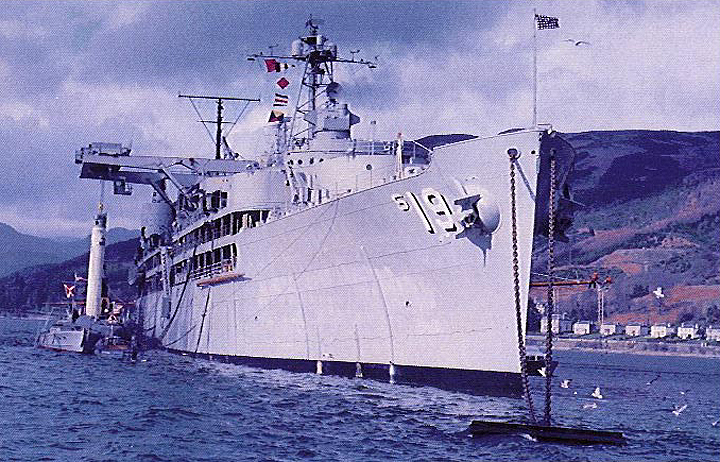 | | Holy Loch, Scotland 1961 - first overseas refit of an SSBN Extraordinary picture of Proteus and Patrick Henry (SSBN 599) transferring a missile in that first re-fit in Holy Loch. The missile handler (the white tube-like object being lifted by Proteus' missile crane) is fitted and locked onto the submarine - so that ships' motions don't effect alignment of the missile in-to or out-of the tube. The missile handler contains it's own internal hoist that actually raises and lowers the missile in and out of the Submarine's launch tube(s). There is a more common black and white picture taken within minutes of this very hard to find color picture -- Our Thanks to Frank Cantrell for digging this one out... |
| 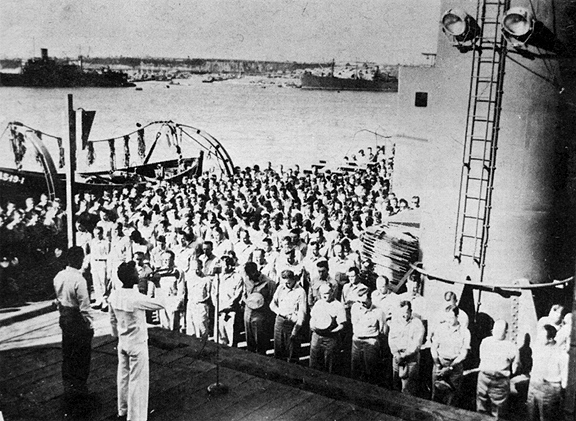 | | USS Proteus in Apra Harbour, 1945 - Memorial Service being held for President Roosevelt. War-time Apra Harbor in the background. The Pacific Daily News, Guam |

Click here for more pictures of the -> USS Proteus AS 19 2006 Reunion
For those interested in following their old ship after she was retired from the Submarine Service --
IX-518 (Ex-Proteus AS-19) from 1992 through 1999.
More USS Proteus History, Pictures and
Click here for Proteus' Page 2
AS 20 USS Otus |
